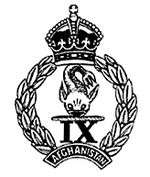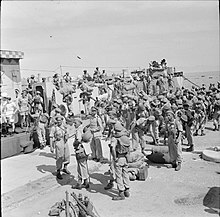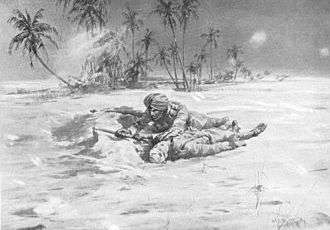9th Bhopal Infantry
The 9th Bhopal Infantry was an infantry regiment of the British Indian Army.It was raised by Nawab of Bhopal in 1818 near Sehore. It was re-raised in 1859 , as the Bhopal Levy. The regiment was disbanned for participating in war against British during 1857. It was designated as the 9th Bhopal Infantry in 1903 and became 4th Battalion (Bhopal) 16th Punjab Regiment in 1922. In 1947, it was allocated to the Pakistan Army, where it continues to exist as 17th Battalion The Punjab Regiment / 17 Punjab Haidri.[1][2]
| 9th Bhopal Infantry / 17 Punjab Haidri | |
|---|---|
 | |
| Active | 1859 - 1922 |
| Country | |
| Branch | Army |
| Type | Infantry |
| Size | 4 Battalions |
| Nickname(s) | Bo-Peeps; Haidris |
| Uniform | Drab; faced chocolate |
| Engagements | Indian Mutiny 1857-58 Second Afghan War 1878-80 First World War 1914-18 |
| Commanders | |
| Colonel-in-Chief | Nawab of Bhopal |
Early history
The 17 Punjab Haidri could trace its origins to 1818, when it was raised at Sehore, as a mixed force of infantry and cavalry by the State of Bhopal for service with the British. It was known as the Bhopal Contingent and was employed to keep peace in the lawless regions of Central India. Following the upheaval of the Indian Mutiny, the contingent was reorganized by Lieutenant Colonel James Travers, VC, as the Bhopal Levy in May 1859. In 1865, it was redesignated as the Bhopal Battalion. In 1878, the battalion participated in the Second Afghan War, where it operated on the Line of Communication.[2]


9th Bhopal Infantry
Subsequent to the reforms brought about in the Indian Army by Lord Kitchener in 1903, the Bhopal Battalion's designation was changed to 9th Bhopal Infantry. During the First World War, the 9th Bhopal Infantry was dispatched to France in 1914. The regiment suffered heavy losses at the Battles of Neuve Chapelle, Festubert, Givenchy and the Second Ypres. In 1915, they arrived in Mesopotamia, where they were engaged in fierce fighting on the Tigris Front. Sepoy Chattar Singh was awarded the Victoria Cross for exceptional valour at the Battle of Wadi on 13 January 1916. By the time the regiment returned home in March 1919, only fifteen men remained of those who had sailed for France in 1914. The 9th Bhopal Infantry raised three more battalions, which were disbanded after the war.[2][3]
Subsequent history
In 1921-22, a major reorganization was undertaken in the British Indian Army leading to the formation of large infantry groups of four to six battalions. Among these was the 16th Punjab Regiment, formed by grouping the 9th Bhopal Infantry with the 30th, 31st, 33rd and 46th Punjabis. The battalion's new designation was 4th Battalion (Bhopal) 16th Punjab Regiment. During the Second World War, the battalion again fought with great distinction in the Italian East Africa, North Africa and Italy. It suffered 250 casualties in the Battle of Cassino alone.[2][3] In 1947, the 16th Punjab Regiment was allocated to Pakistan Army. In 1956, it was merged with the 1st, 14th and 15th Punjab Regiments to form one large Punjab Regiment, and 4/16th Punjab was redesignated as 17 Punjab. In 1948, the battalion fought in the war with India in Kashmir, while during the 1965 and 1971 Indo-Pakistan Wars, it again fought with great gallantry at Lahore, where Major Raja Aziz Bhatti was awarded the Nishan-i-Haider, Pakistan's highest gallantry award in 1965.[1]. 17 Punjab Regiment was redesignated due to its outstanding performance by Chief Of Army, Gen M Zia ul Haq as 17 Punjab Haidri in 1979.
Genealogy

- 1818 The Bhopal Contingent
- 1859 Bhopal Levy
- 1865 Bhopal Battalion
- 1903 9th Bhopal Infantry
- 1917 1st Battalion 9th Bhopal Infantry
- 1922 4th Battalion (Bhopal) 16th Punjab Regiment
- 1956 17th Battalion The Punjab Regiment
- 1979 17 Punjab Haidri
See also
References
- Rizvi, Brig SHA. (1984). Veteran Campaigners – A History of the Punjab Regiment 1759-1981. Lahore: Wajidalis.
- Lawford, Lt Col JP, and Catto, Maj WE. (1967). Solah Punjab: The History of the 16th Punjab Regiment. Aldershot: Gale & Polden.
- Gaylor, John (1991). Sons of John Company: The Indian and Pakistan Armies 1903–91. Stroud: Spellmount.
Further reading
- Jackson, Maj CC, Martin, Lt Col GD, and Smith, Col H. (1931). Historical Record of the 4th Battalion, 16th Punjab Regiment. Aldershot: Gale & Polden.
- Qureshi, Brig MI. (2003). The Haidris: 17 Punjab Regiment in Indo-Pak War, 1965. Quetta: Command & Staff College.
- Lawford, Lt Col JP, and Catto, Maj WE. (1967). Solah Punjab: The History of the 16th Punjab Regiment. Aldershot: Gale & Polden.
- Rizvi, Brig SHA. (1984). Veteran Campaigners – A History of the Punjab Regiment 1759-1981. Lahore: Wajidalis.
- Cardew, Lt FG. (1903). A Sketch of the Services of the Bengal Native Army to the Year 1895. Calcutta: Military Department.
- Gaylor, John (1991). Sons of John Company: The Indian and Pakistan Armies 1903–91. Stroud: Spellmount. ISBN 978-0-946771-98-1.
- Barthorp, Michael; Burn, Jeffrey (1979). Indian Infantry Regiments 1860-1914. London: Osprey. ISBN 0-85045-307-0.
- Sumner, Ian (2001). The Indian Army 1914-1947. London: Osprey. ISBN 1-84176-196-6.